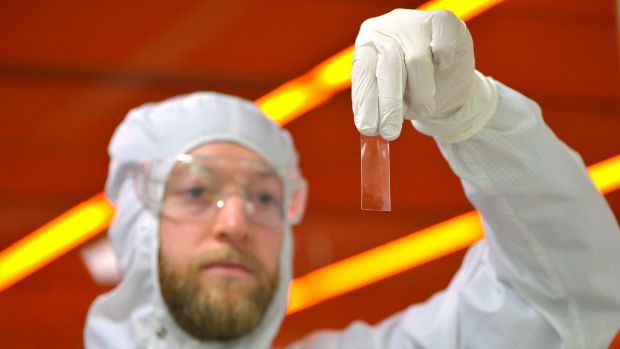
RMIT researcher Philipp Gutruf with a transparent wearable sensor. Photo: Joe Armao
You’ve heard of smart televisions and smartphones. Now get ready for smart skin.
Able to alert the wearer to harmful levels of UV radiation which can lead to skin cancer, the technology developed by RMIT researchers involves wearing stretchy electronic sensors which monitor UV-levels in real time.
“If you are at the beach you could wear this device like a rubberband around your wrist or as a skin patch and jump into the ocean, it will be able to monitor the UV levels and tell you if you have had too much,” material scientist Philipp Gutruf said.
Developed by RMIT’s Functional Materials and Microsystems group, the flexible material contains fine layers of zinc oxide which act as the UV sensing material. Zinc oxide is also used in sunscreens.
Mr Gutruf said the patch or band could be wirelessly linked to electronic devices such as a mobile phone or tablet which would alert the user to high UV radiation levels.
Published this month in the journal Small the research marks a new direction for such technology, as the transparent material has been developed using a rubber rather than a silicone base for the electronics. The rubber gives the functional part in the device much greater flexibility.
“This has been hard to do because rubber doesn’t usually withstand the temperatures of processing,” Mr Gutruf said. “And because they are so flexible and stretchable you can integrate them into clothes, backpacks, gloves and so on.”
The new material is not limited to detecting and monitoring UV radiation either. The research group’s co-leader Madhu Bhaskaran said the zinc oxide could also be tailored to detect toxic gases such as hydrogen and nitrogen dioxide.
Dr Bhaskaran said in industries such as coal-fired power stations, early warning systems which flagged the risk of an explosion were vital. Meanwhile the material could also be used in to monitor nitrogen dioxide levels and pollution in big cities in real time.
“The smart thing here is that with these sensors can be integrated very easily,” Mr Gutruf said “Either into clothing or onto the skin. It is a seamless way on integrating sensors on to the human body.”
He said the materials used to make the sensors also had the advantage of being cheap and durable.
